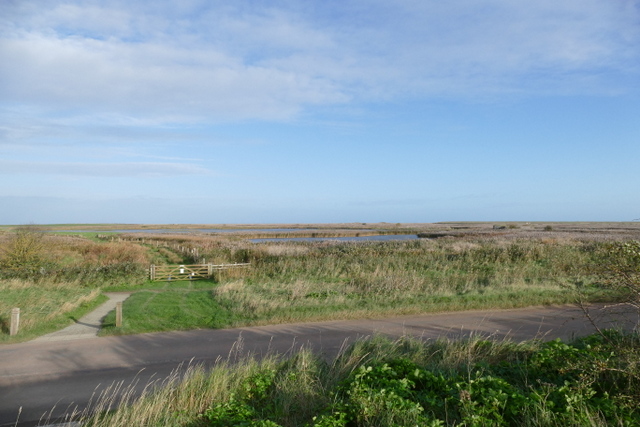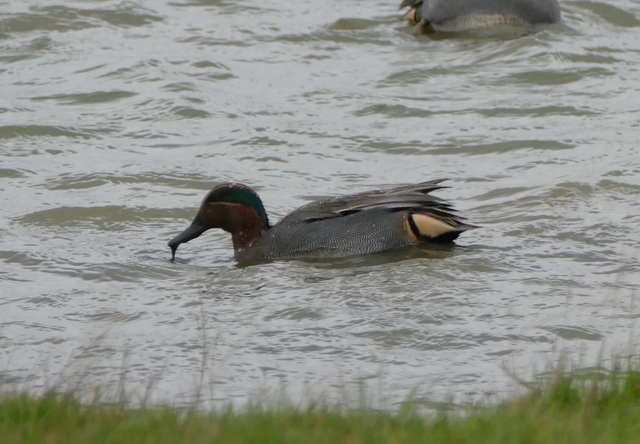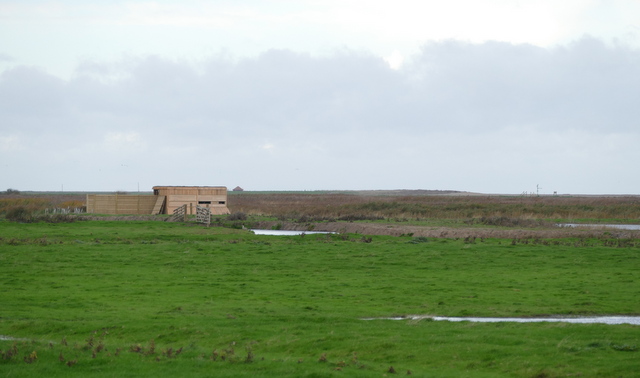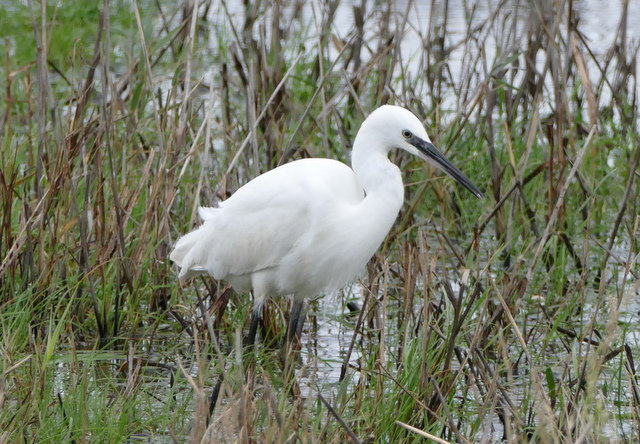Day 1 of a long weekend of tours today. We met at Cley and the plan was to spend the day at the eastern end of the North Norfolk coast. It was beautifully sunny out across the reserve when we arrived, and we could hear the evocative sound of Pink-footed Geese calling as they landed in the fields behind the car park, but we could already see grey clouds building to the west.
 Cley Marshes – in the early morning sunshine
Cley Marshes – in the early morning sunshine
A Black Brant, the NW North American or far Eastern Siberian form of Brent Goose, has been in with our regular flock of Russian Dark-bellied Brent Geese at Cley for a couple of weeks now. There had been no sign of it in the Eye Field before we met up but, from the car park at the Visitor Centre, we saw a huge flock of wildfowl and waders flush from North Scrape. There were lots of Brent Geese in amongst them and most of them seemed to land in the Eye Field, so we drove round for a look.
 Black Brant – standing out among the regular Dark-bellied Brents
Black Brant – standing out among the regular Dark-bellied Brents
The geese were quite close to the road and we picked the Black Brant up immediately without getting out of the car. It was much darker than the other Brent Geese, brownish black on the back and belly, with a larger and whiter patch on the flanks. We wound down the windows and had a good look at it, then drove on to the car park and set up the scopes. We could see its more extensive white collar as it fed with the flock, occasionally lifting its head up and stretching its neck to give us a better look. A smart bird to start the day.
 Black Brant – a striking bird up close
Black Brant – a striking bird up close
As the grey clouds rolled in it started to spit with rain. We were forecast a band of rain to pass through this morning, so we made a dash for the beach shelter and had a look out to sea. Almost immediately we picked up two drake Goldeneye flying west just offshore. There were several Gannets circling out over the sea, both black-tipped white adults and dark slaty juveniles. A Red-throated Diver was preening just off the beach and gave us great views in the scope. We waited a short while but as the rain seemed to be holding off and there were not many birds moving past, we decided to make a dash round and onto the reserve.
We got into Bishop Hide just before the rain really started. There were plenty of birds to look through, with lots of ducks in now for the winter. A little group of Teal were feeding just in front of the hide. There were lots of Wigeon and we could hear them whistling constantly. Smaller numbers of Shoveler were feeding over towards the back and three Pintail were hiding amongst the sleeping hordes. There were fewer waders on here today – a fair number of Black-tailed Godwit, a few Lapwing, but only one Dunlin. Our first Marsh Harrier of the day circled over the reeds.
 Teal – a small group was feeding in front of Bishop Hide
Teal – a small group was feeding in front of Bishop Hide
Thankfully the rain stopped as quickly as it started and the clouds lightened, so we moved on. We headed round to the new Babcock Hide, which only finally opened last month, on the new part of the reserve now sometimes referred to as ‘Salthouse Marshes’. There were more Brent Geese feeding on the grazing meadows by the new path (‘Attenborough Walk’) – the first small group were too nervous to stay as we walked past and took flight, but the rest of the flock reassuringly stayed put. A couple of Egyptian Geese were typically unconcerned!
 Babcock Hide – the new hide on what was known as Pope’s Marsh
Babcock Hide – the new hide on what was known as Pope’s Marsh
The pool in front of Babcock Hide (now known as ‘Watling Water’ – too many new names to keep up with!) looked rather lifeless initially, apart from a couple of Little Grebes. A careful scan revealed a single Common Snipe asleep on one of the islands. A smart male Marsh Harrier quartered the reeds in front of us, but a Merlin over towards Salthouse was too brief for everyone to get onto. A Little Egret was fishing in the shallow water in front of the hide.
 Little Egret – feeding in front of Babcock Hide
Little Egret – feeding in front of Babcock Hide
We had really hoped to see a Water Pipit. There had been up to four of them here in recent weeks, but with a very blustery wind blowing around the exposed margins of the water, it was deserted apart from a single brave Pied Wagtail. Frustratingly we heard a Water Pipit call, which prompted us to give it a little longer. Just when we were about to give up, not one but two Water Pipits flew in. One of them gave us great views as it fed along the edge of one of the islands. Well worth the wait!
 Water Pipit – one of two which eventually gave themselves up for us
Water Pipit – one of two which eventually gave themselves up for us
While we were waiting for the Water Pipit to appear, we had seen news of a Glossy Ibis a short distance east at Felbrigg Park, but it appeared to have flown off. Having admired the Water Pipits, we saw that it had returned so we decided to make our way over there to try to see it. It was only a short drive and after a quick break for lunch in the car park, we made our way down to the lake.
Unfortunately, by the time we got to where it had been showing, it had flown off again, apparently spooked by a Pied Wagtail! Worse, it was reported to have flown way off over the trees in the distance and away. Two people had set off across the grazing marshes to look for it and were already disappearing in the distance without success, so we walked back to have a look at the lake. As we did so, a Barn Owl came out of the trees in front of us and flew across to the other side of the grazing marshes.
There was a single female Goldeneye in amongst the Tufted Ducks out on the lake, but nothing else of note. We knew the Glossy Ibis had already flown off and returned once to where it had been feeding, so it still felt like not all hope was necessarily lost. We continued to scan over the grazing marshes just in case. We saw the two intrepid explorers returning in the distance, their expedition to try to relocate it obviously having been unsuccessful. As they made there way back they suddenly stopped and started to look intently at something. We knew what it must be, so headed out across the grazing marshes to join them.
There was the Glossy Ibis, feeding quietly in the stream, hidden from view by the banks and the thick rushes. It was only when you looked back along the line of the stream that you could see it – it obviously hadn’t flown off into the distance after all! We got stunning views of it in the scopes, feeding in the thick vegetation in the water. Mostly brownish from a distance, we could see it had a greenish gloss to the wings up close.
 Glossy Ibis – a striking bird more at home by the Mediterranean
Glossy Ibis – a striking bird more at home by the Mediterranean
Then it flew again, looking oddly prehistoric in flight with long neck and legs, and landed back where it had been feeding before we arrived. A rare visitor more normally found in southern Europe, in the marshes of the Mediterranean basin, Glossy Ibis sometimes turn up further north in the UK at this time of year. A great bird to see and a nice surprise today.
On our way back towards Cley, we stopped off briefly at Kelling. There have been a few Bramblings along the lane here recently, in with a big flock of Chaffinches. But the hedges seemed rather quiet today as we walked down – just a handful of Chaffinches – perhaps most of the finches were feeding somewhere more sheltered today?
We walked down as far as the Water Meadow. The water level is normally very high here through the winter and there were just a few ducks on the pool – Wigeon, Shoveler and Gadwall. A single Redshank and a lone Black-tailed Godwit were feeding around the edge, but several Curlew were out on the damp grass. Further along, towards the Quags, a female Stonechat appeared on top of the brambles.
We made our way back – we wanted to be at Cley in good time – stopping to look at a couple of Chaffinches in the dead trees along the lane as we did so. A few more flew into the hedge from the field and right at the top was a single Brambling!
 Brambling – just one today, along the lane at Kelling
Brambling – just one today, along the lane at Kelling
Back at Cley, we parked in the new East Bank car park. Before we had even had a chance to get out of the car, a falcon appeared over the bank flying straight towards us. Through the windscreen, we could see it was a Merlin – more obliging than the one we had seen briefly earlier. It disappeared west over the reeds. A pair of Stonechat were in the reeds by the path – the male hovering repeatedly in the air above the female, before dropping down to perch.
We climbed up onto the East Bank from where we could get a good view over the reeds on Pope’s Marsh. It was lovely evening light – an increasingly orange sky with scattered cloud at first. There were lots of ducks out on the grazing marsh in front, including a couple of smart drake Pintail, unfortunately mostly asleep! A flock of small birds took off from the reeds and flew over towards the East Bank – a party of 14 Reed Buntings flying in to roost. Scanning along the shingle ridge, a dark shape on the top of one of the fence posts revealed itself to be another Merlin – it had been a good day for them today.
There were a couple of Marsh Harriers already out over the reedbed when we arrived but more started to arrive in ones and twos. At least 12 came into roost this evening – at times, we could see 6-7 circling over the reeds together. We had hoped to see a Hen Harrier here, but we had obviously used up our luck today. The light faded quickly as the cloud rolled in again, so we decided to call it a day. As we turned to head back to the car, we could hear Pink-footed Geese calling again – just as we had heard them flying in to the fields this morning. A flock appeared in the sky from behind the trees and we watched them drop down over towards North Scrape to roost.
















